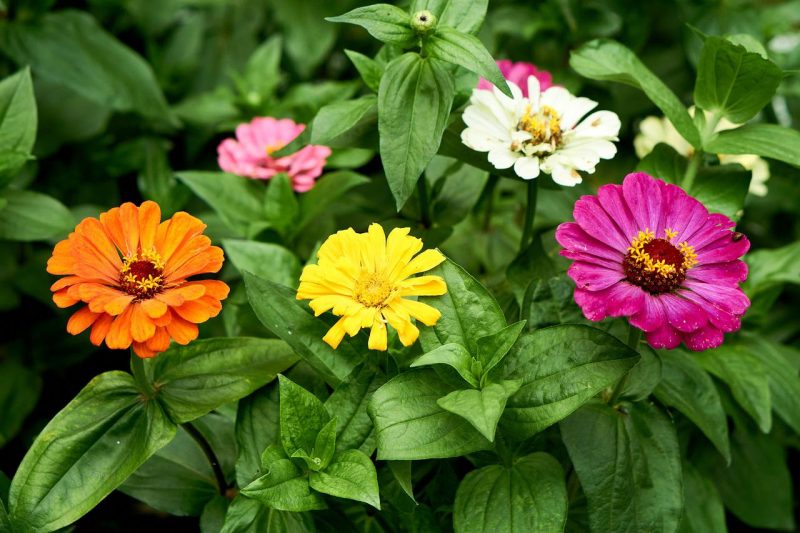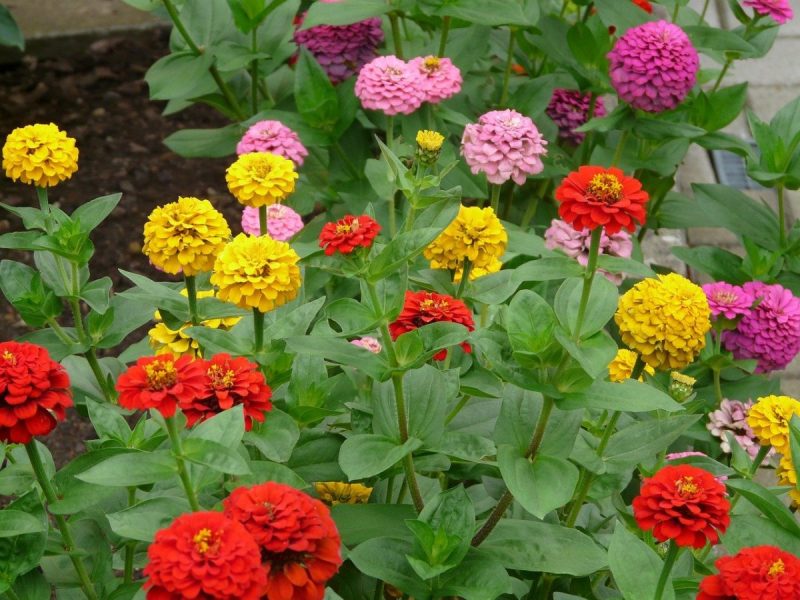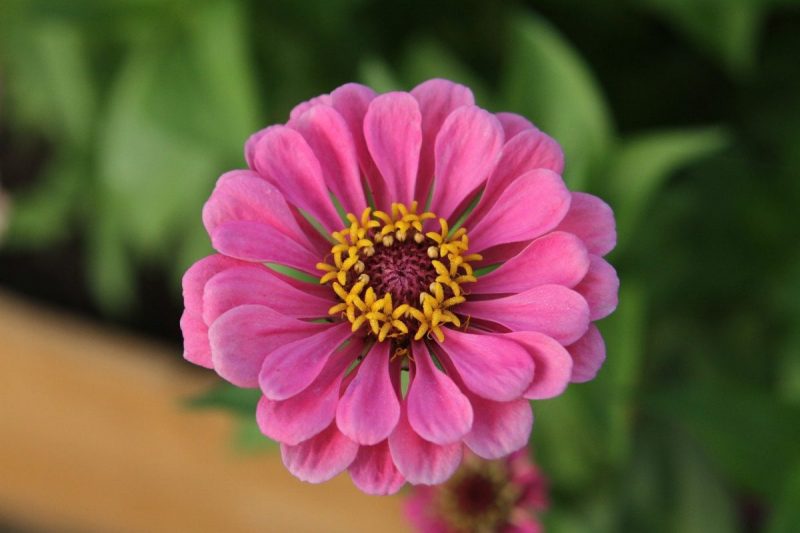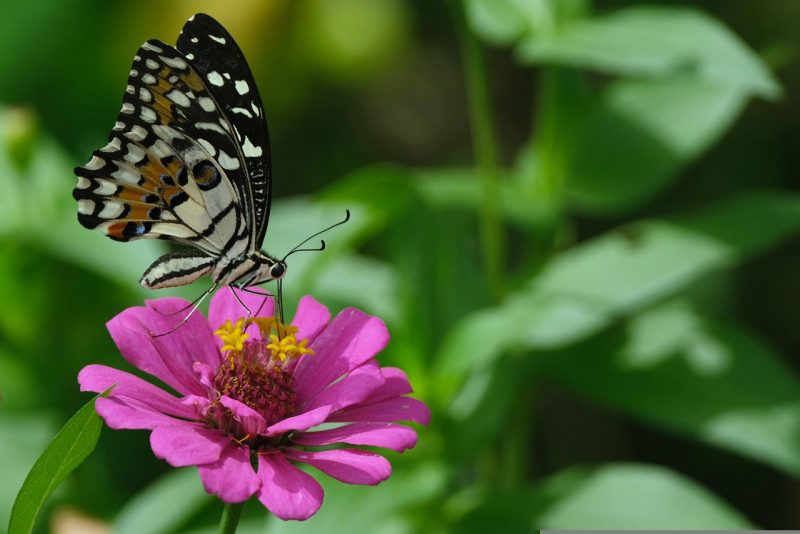Common zinnia, planting guide and care work

Zinnia elegans, popularly called common zinnia, is an annual, herbaceous plant, which is part of the Zinnia genus, Compositae (Asteraceae) family. It is one of the most famous species of the Zinnia genus and has been used to create numerous varieties. The plant has a height between 40 and 100 cm and a dichotomously branched stem. The leaves are oppositely arranged, sessile, ovate-pointed, hairy just like the stem and shoots. Each branch of the stem ends with a calathidium inflorescence, which is made up of small tubular flowers and large ligulate flowers, variously colored (pink, purple, yellow, orange, white, red, green, etc.). The calathidium can be simple or twisted, depending on the position of the ligulate flowers. Flowering takes place from June, until late autumn, when the first frosts fall.
Common zinnia – Varieties
- ‘Thumbelina’: it has involute flowers, which have various colors (pink, purple, yellow, etc.);
- ‘State Fair’: a variety with large stems and flowers in various colors (red, yellow, white, purple, etc.);
- ‘Zahara’: it has large flowers and a resistance to powdery mildew;
- ‘Dreamland’: a dwarf variety with an overall compact appearance and involute flowers;
- ‘Envy’: a variety with involute flowers;
- ‘Orange Star’: a dwarf variety with orange flowers.



Recommended products
-
You can find products on a different store
Change Store -
You can find products on a different store
Change Store -
You can find products on a different store
Change Store -
You can find products on a different store
Change Store -
You can find products on a different store
Change Store -
You can find products on a different store
Change Store -
You can find products on a different store
Change Store -
You can find products on a different store
Change Store -
You can find products on a different store
Change Store -
You can find products on a different store
Change Store -
You can find products on a different store
Change Store -
You can find products on a different store
Change Store -
You can find products on a different store
Change Store -
You can find products on a different store
Change Store -
You can find products on a different store
Change Store -
You can find products on a different store
Change Store -
You can find products on a different store
Change Store -
You can find products on a different store
Change Store -
You can find products on a different store
Change Store -
You can find products on a different store
Change Store -
You can find products on a different store
Change Store -
You can find products on a different store
Change Store -
You can find products on a different store
Change Store -
You can find products on a different store
Change Store
Environmental conditions
Light. Common zinnias bloom abundantly in bright places, where they can benefit from sunlight for approximately 6-8 hours a day. In addition, placing them in a space that also allows good air circulation will help prevent the occurrence of foliar diseases, such as powdery mildew.
Temperature. It is a species sensitive to frost that grows from a minimum temperature of approximately 16 °C during the day, but which prefers an interval between 23-28 °C. Normally, it is not affected by high temperatures during the summer.
Soil. It can adapt to most types of soil, but it is ideal for it to be rich in organic matter and to ensure a good water drainage.
Common zinnia – Care
Watering. Common zinnias are resistant to drought and usually do not require additional watering. Thus, watering is recommended to be carried out moderately, when necessary, depending on the recorded temperatures and the rainfall.
Fertilizing. To stimulate a healthy growth and abundant flowering, it is recommended to regularly administer fertilizers specially formulated for flowering plants.
Recommended products
-
You can find products on a different store
Change Store -
You can find products on a different store
Change Store -
You can find products on a different store
Change Store -
You can find products on a different store
Change Store -
You can find products on a different store
Change Store -
You can find products on a different store
Change Store -
You can find products on a different store
Change Store -
You can find products on a different store
Change Store -
You can find products on a different store
Change Store -
You can find products on a different store
Change Store -
You can find products on a different store
Change Store -
You can find products on a different store
Change Store -
You can find products on a different store
Change Store -
You can find products on a different store
Change Store -
You can find products on a different store
Change Store -
You can find products on a different store
Change Store -
You can find products on a different store
Change Store -
You can find products on a different store
Change Store -
You can find products on a different store
Change Store -
You can find products on a different store
Change Store -
You can find products on a different store
Change Store -
You can find products on a different store
Change Store -
You can find products on a different store
Change Store -
You can find products on a different store
Change Store
Propagation. It is done by seeds. The seeds can be sown directly in the garden (after the danger of late frost and hoar has passed) or in protected areas, being later transplanted in the garden. The optimal temperature for seed germination is 18-20 °C, the plants sprouting within 5-7 days from sowing.
Since their growth rate is quite fast, 7-10 days after sprouting, they are transplanted into alveolar trays or small flowerpots. To stimulate an abundant branching, before planting them in the garden, the seedlings are pinched 1-2 times. The planting of seedlings in the garden will be done after the danger of late frosts and hoar has passed.
Recommended products
-
You can find products on a different store
Change Store -
You can find products on a different store
Change Store -
You can find products on a different store
Change Store -
You can find products on a different store
Change Store -
You can find products on a different store
Change Store -
You can find products on a different store
Change Store -
You can find products on a different store
Change Store -
You can find products on a different store
Change Store -
You can find products on a different store
Change Store -
You can find products on a different store
Change Store -
You can find products on a different store
Change Store -
You can find products on a different store
Change Store -
You can find products on a different store
Change Store -
You can find products on a different store
Change Store -
You can find products on a different store
Change Store -
You can find products on a different store
Change Store -
You can find products on a different store
Change Store -
You can find products on a different store
Change Store -
You can find products on a different store
Change Store -
You can find products on a different store
Change Store -
You can find products on a different store
Change Store -
You can find products on a different store
Change Store -
You can find products on a different store
Change Store -
You can find products on a different store
Change Store
Diseases and pests
Common zinnias can be affected by various leaf spots, powdery mildew and certain soil pathogens. Among the pests, the most common are mites, caterpillars, and wooly apple aphids.
Additionally:
- They are annual plants, which will perish after the first frost in autumn. Thus, the following year it will be necessary for them to be sown again;
- After blooming, dry flowers can be cut to stimulate the appearance of new flowers;
- Depending on the environmental conditions, care works and variety, they bloom 60-70 days after sowing;
- They can also be used as cut flowers, in bouquets;
- Planting/sowing in the garden is carried out in spring, only after the danger of late frost and hoar has passed;
- Common zinnias attract butterflies.















































































































































































































































































































































































































































